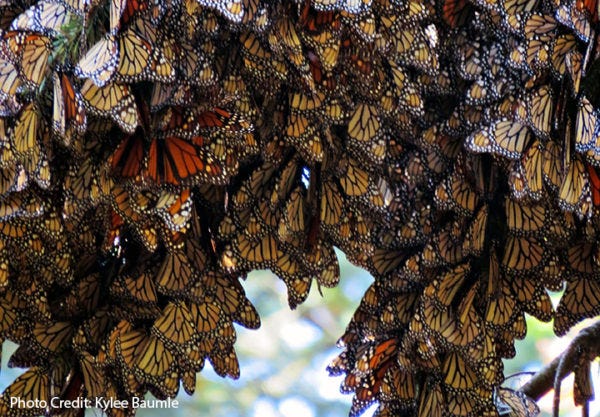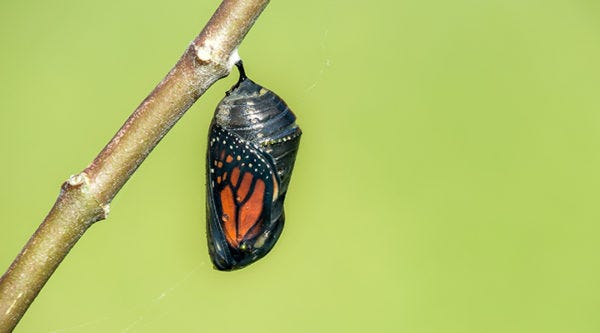Monarch Butterfly Migration: The Incredible Journey
 Monarch butterfly on Butterfly Weed (Asclepias tuberosa).
Monarch butterfly on Butterfly Weed (Asclepias tuberosa).
By Katrina Godshalk
For the vast majority of monarch butterflies living in the eastern US and Canada, an incredible journey begins late each summer. “A butterfly born in Canada or the US begins an epic journey of up to 2800 miles south to a place they’ve never been before – a very specific place, where their great-great-grandparents went the year before, but never the generations in between them,” says Kylee Baumle, author of The Monarch, Saving Our Most-Loved Butterfly. As the days shorten, nights cool off, the milkweed declines, the butterflies begin their journey south and west.
As they travel south, especially through Texas, they begin to be seen in larger and larger groups as they funnel into Mexico and southwards. Not all monarchs make it this far. In addition to the many casualties on the way, some from the east coast move south into Florida and sometimes even to Cuba and will overwinter there. Western monarchs (5%) tend to overwinter along the California coast.
Until 1975, while it was known that monarchs migrated to Mexico, no one knew quite where. After years of research, it was discovered that the monarchs winter over, clustered together in the oyamel fir forests of central Mexico. Here temperatures are cool enough in the winter to slow the butterfly’s metabolism and the fir trees provide protection from strong winds and storms. With a perfect humidity, there are about twelve monarch sanctuaries on scattered isolated mountaintops. Clustering together, the branches sag from the collective weight of the monarchs. Mostly staying in the trees, but occasionally leaving for water and nectar, the butterflies siesta through the winter until spring begins to return. As the days lengthen and warmth returns, the monarchs mate and begin their return north, to begin the cycle of life again.
 Monarchs clustering together in their winter home in Mexico. Photo by Kylee Baumle.
Monarchs clustering together in their winter home in Mexico. Photo by Kylee Baumle.
What’s So Special About Monarch Butterflies?
Monarch Butterflies (Danaus plexippus plexippus) populate most of the eastern US and southern Canada. They also exist west of the Rockies, but in smaller numbers. Sightings of monarchs occur in almost every state.
A monarch butterfly’s life is intrinsically woven with the milkweed plant (Asclepias), a once-common native perennial plant, throughout its range. Its life begins when a female lays an egg on the underside of the leaf or other part of a milkweed plant. In three to five days, a very tiny, hungry caterpillar emerges and begins feasting on the milkweed plant. As the caterpillar grows to full size, it goes through five molts, stages of life, that are each a large step to becoming a butterfly. Each time the caterpillar literally sheds its skin and reforms a larger one. At the final molt, in about 10-14 days, the caterpillar is a beautiful yellow-green-black striped color about 1 ¾ inches long. Now the caterpillar wanders from the milkweed plant and finds just the right spot. It spins a pad of silk, and attaches itself, hanging upside down. After many hours, its skin will split to reveal its translucent green chrysalis that is its home for the next 11-15 days as it takes its final form as a monarch butterfly. Once emerging, and after drying its beautiful orange wings, it takes flight to find nectar, its new food. The monarch butterfly will live from two to six weeks, during which time it will mate, and begin the cycle again. This cycle may happen from four to five times per summer, four to five generations, and on the final generation of the summer, called the Methuselah generation, something really amazing happens. These butterflies, with more densely scaled and slightly larger wings, will live from seven to eight months.
 Monarch caterpillar on a Milkweed (Asclepias) plant.
Monarch caterpillar on a Milkweed (Asclepias) plant.
Challenges Faced By Monarch Butterflies
I remember, as a child, the puffing clouds of milkweed silk that popped open on summer days along corn fields and in the meadows of my childhood home. Sometimes we would spot a monarch butterfly flitting among the plants. Even as children we all knew they were beloved creatures and true butterfly royalty.
Now, many years later, the field-side borders and patches of meadow are hard to find. With their disappearance, so too has followed the fate of our most iconic North American butterfly, the monarch. Over the past 20 years, their population has declined 90%.
While there are many challenges to the survival of the monarch butterfly, such as logging in Mexico, herbicides, pesticides and climate change; we, as gardeners, can have an impact on their survival. By understanding their life cycle, we can play an important role in recreating good monarch Butterfly habitat.
 Monarch caterpillar emerging from its chrysalis.
Monarch caterpillar emerging from its chrysalis.
Gardeners Can Help Create Habitat For Monarchs
One of the most important factors in the survival of monarch butterflies is the presence of milkweed (Asclepias). 1.3 million stems of milkweed are needed to restore habitat in the monarch’s range and many groups are working to achieve this. If everyone who lives in a monarch breeding area planted a few Asclepias (milkweed) plants, not only would they enjoy the beautiful flowers, but they would be contributing to the restoration of a vital food source for the monarch butterfly. There are over 30 native species of milkweed in the US that monarchs are known to feed from. According to Professor Lincoln Brower, Research Professor of Biology at Sweet Briar College, “Planting native plants that grow naturally in your area is one of the best ways to support monarchs as well as pollinating insects.” Common milkweed (Asclepias syriaca) is a good starting place as its range covers most of the US. Swamp milkweed (Asclepias incarnata) is another good choice for most of the country except the far West. Asclepias tuberosa, with its bright orange flowers, is a beautiful addition to a butterfly garden and is native to many areas. Be sure to have a full season of nectar rich flowers available too, to feed the butterflies. The Xerces Society has been working to protect invertebrates since 1971, their website LINK has planting guides for every area of the US.
Protect Monarch Butterflies from Harmful Chemicals!
Lastly, and vitally important, is the effect of pesticide and herbicide spraying over much of our agricultural fields and in our landscapes. In our own gardens, we can learn to eliminate or use less by learning to garden naturally. Professor Brower advises, “Supporting local, organic agriculture is another important way to support our local pollinators.” The rise in the use of genetically engineered crops have been accompanied by a huge increase in the application of herbicides. Let your representatives know you are concerned by the plight of our monarch butterflies and other pollinating insects. Together, we can bring them back and create a renewed ecosystem that supports the health of all.
Shop Asclepias (Milkweed)
© All articles are copyrighted by High Country Gardens. Republishing an entire High Country Gardens blog post or article is prohibited without written permission. Please feel free to share a short excerpt with a link back to the article on social media websites, such as Facebook and Pinterest.